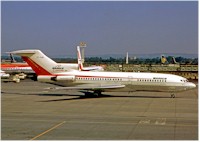Having read the recent articles on Wardair and the B-727 CF-FUN, Don Saunders has sent us this memory -
WARDAIR B727-11 CF-FUN
 I believe I can fill in some of the details on the operation of CF-FUN.
I believe I can fill in some of the details on the operation of CF-FUN.
I started flying with Wardair on the DC-6 when the company's overseas operation started in the spring of 1962. The 1962 start utilized a DC-6B passenger freighter leased from Canadian Pacific Airlines, CF-CZZ. This aircraft was returned to CPA in the fall of 1962 and in the spring of 1963, the company purchased a used DC-6B from KLM, CF-PCI.
As the overseas charter operation demand increased each year, the company started to look to upgrade to a jet airplane. Negotiations commenced with Boeing in 1965. The polar route had been flown very successfully by Pan Am, SAS, CPA, Wardair and other carriers with piston engine machines, for the many years prior to the advent of the jet era. All these airlines had utilized the Danish/ USAF base on the west coast of Greenland just north of the Arctic Circle, Sondre Stromfjord (Kangerlussuaq). The USAF operated from one side of the airport and SAS operated the hotel/terminal building on the other.
Due to the influence of the very cold Greenland Ice Cap with its dominant and consistent high pressure area, the outflow winds off the ice cap kept the weather at the airbase unusually clear especially during the summer. The 9000 foot runway is situated at the ice cap end of the fjord. One way in and one way out. The USAF operated a GCA radar unit which allowed a safe approach to the runway even though the terrain along the fjord walls rose up in some areas over two thousand feet. Frobisher Bay (Iqaluit) and Keflavik were used as alternates.
Boeing and Transport Canada worked with Wardair and determined that the B727 could be operated with better fuel reserves than the previous piston engine operations utilizing long range cruise power settings and a modification to the fuel tank system to increase the range. "FUN" was delivered to Edmonton in March 1966. The crews were all trained at Boeing.
"FUN" was operated very successfully out of all the Western Canadian airports, on this polar route, to just about every major UK and European destination. "FUN" operated out of Toronto and Montreal using Gander, Goose Bay, Shannon and Prestwick as fueling stops. The airplane did a round trip to Europe each day and in summer 1966 had a utilization of over eighteen flying hours a day, far above any other 727 operator. The airplane rotated through Gatwick Airport nearly every day from Canada so that there was talk that the company had several 727’s.
The refueling stops in Greenland and Iceland were very popular as the passengers were able shop duty free and, as well, purchase native artifacts, stretch their legs and claim they had been to the Arctic. As the charter industry was still developing, the company decided that there was not enough business in the winter of 1966-1967 and leased FUN to National Airlines. It was back in action in the spring of 1967. Gradually there became a demand for sun spot winter travel and FUN operated in the winter months to the Caribbean, Mexico and Honolulu.
The airplane was flown with two pilots, a navigator and a maintenance qualified flight engineer. Four stewardesses served the filet steaks on Royal Doulton china along with the complimentary drinks. It was a wonderful era in the airline world for passengers and the flight crews as well.
FUN was eventually sold as Wardair moved on with the purchase of B707’s, B747’s and DC-10’s. During the twenty eight years that Wardair operated all around the world there was not a single passenger injured nor any of the airplanes lost. An outstandingly “FUN” airline operation.
Captain Don Saunders. (retired)
Keith Rhodes shares his memories of Air Transit -
I remember a few high points of this venture.
I don't know who the instigators were, probably the Quebec government, probably at the behest of Mayor Drapeau, but the plan was an Expo 67 airport on the old Victoria Municipal dump to Toronto Island and Rockcliffe, Ottawa.
Air Canada was asked to provide technical expertise in equipping and operating the service with the DHC-6 aircraft, and I was one of the team selected to help out. I cannot remember any other team members, except Captain Ron Baker, who was at the time in Flight Operations Engineering, co-located with Maintenance Engineering. We went on one visit to the DH plant in Malton, had a meeting with their development team to discuss what was needed on DHC-6 to make it suitable for the task. I remember they were astounded at the quantity and weight of the radios and navigation system instruments suggested by Ron and his team. After the meeting, we were flown back from Malton to Toronto in a demo DHC-6. The pilot landed in the undershoot of runway 24L, came to a halt, then turned off on to the taxiway used to enter the runway - quite an effective demonstration of STOL operations.
Regarding the Bristol Freighters, they were commonly referred to as Bristol Frighteners. TCA Engineering and Maintenance totally rewired all of them before they went into service to eliminate a known type of wiring joint used by Bristol - ball and socket, I believe.
Keith Rhodes
